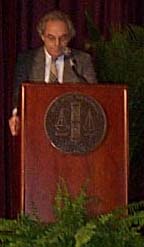|
WHERE IT
BEGAN
continued from page 1
|

Professor Paul Lovejoy explains the Nigerian Hinterland Project.
|
Though this may
seem like a vast stretch of land, Lovejoy explained the significance
of thi s information: It gives rise to the possibility that someday,
Africans around the world will be able to have a fuller understanding
of their ancestral background.
In his presentation,
Lovejoy expounded on the emergence of the Nigerian Hinterland Project,
for which he serves as executive committee director. The region
includes the interior of the Bights of Benin and Biafra. (A bight
is the bend in a coast forming an open bay.)
|
Nigerian
Hinterland Project
The
Nigerian Hinterland Project, which was outlined Oct. 5 at
the NYU "Slave Routes" conference by its director, Prof. Paul
Lovejoy of Canada's York University, is an investigation into
the history of enslaved people who originated in the interior
of the Bights of Benin and Biafra. Affiliated with the UNESCO
Slave Route Project, Lovejoy's institute has seven distinct
aims in its research:
- To
build archives of primary sources related to the Nigerian
diaspora and its origins, and to increase access to them;
- To
compile a database of enslaved Africans, including a summary
of biographical information on individuals and direct quotations
about the individuals;
- To
map out a historical atlas of slavery, which would summarize
information on the slave trade and slaves' roots in formats
accessible on CD-ROM and the Internet;
- To
study the ports of the Nigerian Hinterland in relation to
European and American ports;
- To
explore the Muslim diaspora and its connection to the routes
of the slave trade, slave routes, in part by using the collection
of Arabic documentation on enslaved Africans in Islamic
areas;
- To
examine the ethnic identities in the diaspora and the Nigerian
Hinterland by looking at their language groups (Aja/Fon,
Yoruba, Igbo, Hausa and Kanuri); and
- To
study links between the diaspora and the Nigerian Hinterland.
Those
wishing to learn more about the project's goals and upcoming
events can see the project's site.
Nigerian
Hinterland Project
|
Some 40 percent
of all slaves who ended up in the Americas - North and South America
and the islands making up Hispaniola - can trace their origins to
this region. The project concentrates on the massive population
displacement, exploring the effects on historical developments in
Africa and elsewhere. The program currently involves a network of
scholars and institutions and explores the ways in which enslaved
Africans contributed to changes in world culture, especially in
Atlantic regions.
Lovejoy stressed
the importance of several aspects of the project, including an effort
to create an archive of material on the subject, so that later generations
can continue the research.
Lovejoy
also touched upon the societal makeup of Africa just before the
slave trade began, sharing information that, though known for some
time, has relevance to present research on African history. As he
explained in a 1983 book entitled
Transformations in Slavery: A History of Slavery
in Africa, Africans lived in societies of complex social
structures, complete with political figures, religious leaders,
and even slavery and other forms of dependency.
Responding to
a question about these forms of dependency in pre-European Africa,
Lovejoy said, "There was an absolutely fundamental difference between
slavery in Africa and slavery in places such as the Americas."
As he explained
it, the power of an African chief was calculated in direct proportion
to the number of his subjects. Lovejoy explained that warfare was
often a means of acquiring new subjects. The vanquished would enter
the tribes as slaves but, like any other tribal member, had opportunities
to be liberated at some future point.
This would change
with the emergence of the slave trade. Instead of keeping prisoners
of war as slaves and eventually allowing them to integrate into
society, African chiefs began to trade them to white men in exchange
for European goods.
In a way, he
said, European goods had become a new way for an African chief to
display his power -- that is, more so than sheer numbers of subjects.
As European goods became more and more fashionable in Africa and
the demand for slaves grew -- especially in Europe, the Americas,
and even the Orient -- African tribes began to fight each other
for the sole purpose of capturing their neighboring tribe members
and selling them directly to white slave traders.
Unfortunately,
Lovejoy said, this trend would continue until the societal structures
all along the western coast of Africa and west central Africa had
changed, forming patterns of instability and poverty that plague
African peoples across the continent to this day.
|

![]()
